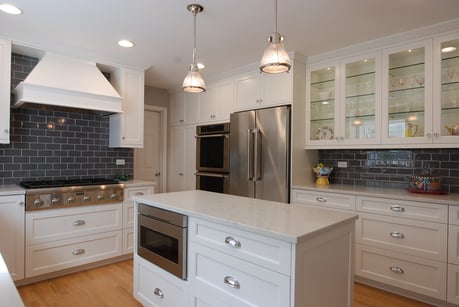 The best Chicago kitchen designs work from the macro- to the micro. We start by taking your kitchen function as a whole, and we keep that in mind as we work to accommodate that with all the features, fixtures and finishes that align with your preferred style.
The best Chicago kitchen designs work from the macro- to the micro. We start by taking your kitchen function as a whole, and we keep that in mind as we work to accommodate that with all the features, fixtures and finishes that align with your preferred style.
Once we’ve covered the macro-, or more general Q&As, we move through the micro-, or nitty gritty, details that take an overall design from great to amazing.
Answer these questions before completing your Chicago kitchen design
Before you move forward with a single installation, make sure you’ve answered these questions so you know every little detail was considered – and customized - to your kitchen use and preferences.
1. What will be the shape of your countertop edges?
Much attention goes into the selection of the countertop – and understandably so. After cabinets, your countertop materials are typically the second-most visible feature in your kitchen. As we’ve mentioned in previous posts, not all countertop edges are created equal.
Some, like the sunken ogee, have lots of dimension and add a lovely finishing touch in a traditional kitchen design. Others, like a single bevel, are distinctively modern – but leave sharp corners that aren’t as well-suited to families with young children ("ouch!," says the tender head...). Price may also be a factor as some countertop edges are more expensive than others.
2. Hardware: How will doors and drawers open (pull, knobs, or other?)
There are tips and tricks for choosing door and drawer hardware that suits your kitchen’s form and function. Things to consider:
- Would you prefer all of them to be the same for simplicity and consistency’s sake?
- Are you planning to age-in-place or do you have young children (accessibility is worth considering).
- Are you up for trying the trending mixed-metals approach or would you prefer something more timeless?
- Are you thinking to skip hardware altogether for the sake of a streamlined look? If so, make sure you’re up for more routine wiping/cleaning since your doors/drawers will bear more prints, stains, and smudges this way.
3. Do you prefer an over- (drop-in) or undermounted sink?
Often, clients have a sink product picked out, only to learn it doesn’t mount the way they want it to. Most kitchen sinks - excluding granite and Corian sinks that are flush with countertops – are either installed into and over the countertop (overmounted or drop-in), which means there’s a raised sink edge between the countertop and the sink, OR they are mounted underneath the sink, so you can swipe food, crumbs, etc., right across the counter and into the sink.
Read, Should I Do a Drop-In or Undermount Sink?, to learn more about the pros and cons of each. Decide which you prefer and then make your sink selection(s).
4. What’s your preferred countertop finish?
We spend lots of time talking about cabinet finishes, but many clients aren’t aware that certain countertops come in finish options. For example, if you choose a granite or quartz countertop, you’ll have the option to have it polished to a glossy finished, or fabricated to have a matte look; the former is shiny and reflective, while the latter offers a softer and more organic look.
Polished finishes show stains and minor abrasions more easily, but matte finishes mean you’ll need to seal your granite diligently as its pores are left more exposed. Interested in designing a low-maintenance kitchen? Then we recommend quartz – which allows you to enjoy a matte finish and not have to worry about sealing, etching, staining or scratching.
5. What color or material will your toe kick be?
What’s a toe kick, you might ask? The toe kick is that small, vertical space between the lower cabinets and floor. Historically, the toe kick was matched to the cabinets and that was that. Now, homeowners have more options.
Considerations include:
- Using the same paint colors that are on the wall behind it.
- Feeling free to use a different toe kick material/color on perimeter vs. the island if you’ve mixed-and-matched cabinet materials or colors in the kitchen.
- Use stainless steel on all toe kicks for consistency and toe scuff durability
- Use a darker color there to hide the inevitable scuffs and marks if you have light cabinet finishes
Finally, as long as we’re talking about toe kicks – don’t forget to consider them as part of your kitchen lighting design. It’s part of the safety and ambient lighting categories.
Don’t neglect the nitty gritty details in your Chicago kitchen remodel. Schedule a consultation with Kitchens & Baths Unlimited and we’ll make sure every last detail is completed to perfection.



